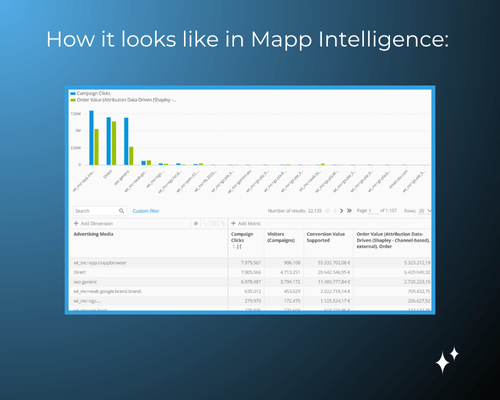Want to solve one of marketing's biggest mysteries? We're happy to announce the rollout of our data-driven attribution model for all Mapp Intelligence accounts.

Marketing attribution has always been something of a detective story. A customer converts, but who gets the credit? Was it the search ad that first caught their attention? The email that brought them back? Or the display ad they saw just before purchasing?
For years, marketers have relied on simple rules to solve this mystery. But like a lazy detective who blames the first person they see at the crime scene, these rule-based models often miss the bigger picture.
Today, we’re excited to announce that our data-driven attribution model is now available to all users. But before we explain how it works, let’s talk about why traditional attribution falls short and why that matters for your marketing budget.
Most attribution models follow simple rules:
First-Touch Attribution credits the first channel a customer encountered. It’s like a detective who arrests the first person at the crime scene without investigating further.
Last-Touch Attribution gives all the credit to the final touchpoint before conversion. This is equally simplistic. It’s pretty much assuming the last person who saw the victim must be responsible.
Linear or Time-Decay Models try to split the difference, distributing credit according to predetermined formulas (like 40% first touch, 40% last touch, 20% everything in between).
These approaches share a fatal flaw: they ignore your actual data. They apply the same rules to every business, every customer journey, and every conversion, regardless of what actually drives results in your unique situation.
When attribution is wrong, budget allocation follows suit. You might be:
In the metaphor from our presentation: they’re all collaborating, Murder on the Orient Express-style. We need a better detective.
Many “data-driven” attribution solutions today suffer from a critical flaw: they’re black boxes. These algorithms use machine learning or proprietary methods to calculate attribution, but they can’t explain why they assigned credit the way they did. You’re left trusting a system you don’t understand, making decisions based on recommendations you can’t verify.
We took a different path. We wanted an attribution mechanism that was both sophisticated and transparent, one that you could actually understand and trust.
That’s why our data-driven attribution model uses Shapley values, a concept from game theory that was championed by GroupM for marketing attribution. Named after Nobel laureate Lloyd Shapley, this approach answers a simple question: What is the fair way to distribute credit among collaborators?
The beauty of Shapley values is that they’re not a black box. The logic is mathematical, provable, and most importantly: explainable. You can see exactly how the attribution was calculated and why each channel received the credit it did.
Instead of following predetermined rules, our system analyses your actual customer journey data to understand each channel’s true contribution. Here’s the process in brief:
Want more technical details? Our implementation is based on the simplified Shapley value approach, which uses an efficient calculation formula that dramatically improves computational performance while maintaining mathematical rigor. You can read the full methodology in this research paper: Shapley Value Methods for Attribution Modeling in Online Advertising (Zhao, Mahboobi & Bagheri, 2018).
We know what you’re thinking: “But what if I don’t have enough data yet?”
We’ve built in an intelligent cold start process:
• Initially, we distribute credit equally among channels while collecting journey data
• For new channels, they receive an equal share until we have enough data to calculate their true contribution
• As data accumulates, we smoothly transition to data-driven attribution
This ensures you get useful insights from day one, with increasing accuracy as your data grows.
With data-driven attribution, you can:
Make smarter budget decisions based on actual performance, not arbitrary rules.
Understand why the attribution works rather than trusting a black box algorithm.
Explain your methodology to stakeholders with confidence, because the math behind it is transparent and verifiable.
Understand channel synergies and see how different touchpoints work together.
Optimise the entire journey rather than just the first or last click.
Adapt automatically as your marketing mix evolves and customer behaviour changes.
Unlike opaque machine learning models that can’t explain their reasoning, Shapley values give you attribution you can understand, trust, and defend in budget meetings.
Previously offered as a premium feature, data-driven attribution is now included for all users at no additional cost for all Mapp Intelligence customers. We believe every marketer deserves access to sophisticated attribution that reflects their unique customer journey.

While data-driven attribution can be applied to various conversion metrics, we recommend starting with order value. This gives you the clearest picture of how different marketing channels contribute to actual revenue, making budget allocation decisions more straightforward.
That said, the same approach can be applied to other goals. Think lead submissions, sign-ups, content downloads, or any other conversion metric that matters to your business. Once activated, the system will begin collecting customer journey data immediately and transition to data-driven attribution once sufficient data is available.
Solving the attribution mystery shouldn’t require a premium subscription. It should be standard equipment for anyone trying to understand what their marketing is really accomplishing.
Ready to become a better marketing detective? Your data-driven attribution model is waiting.